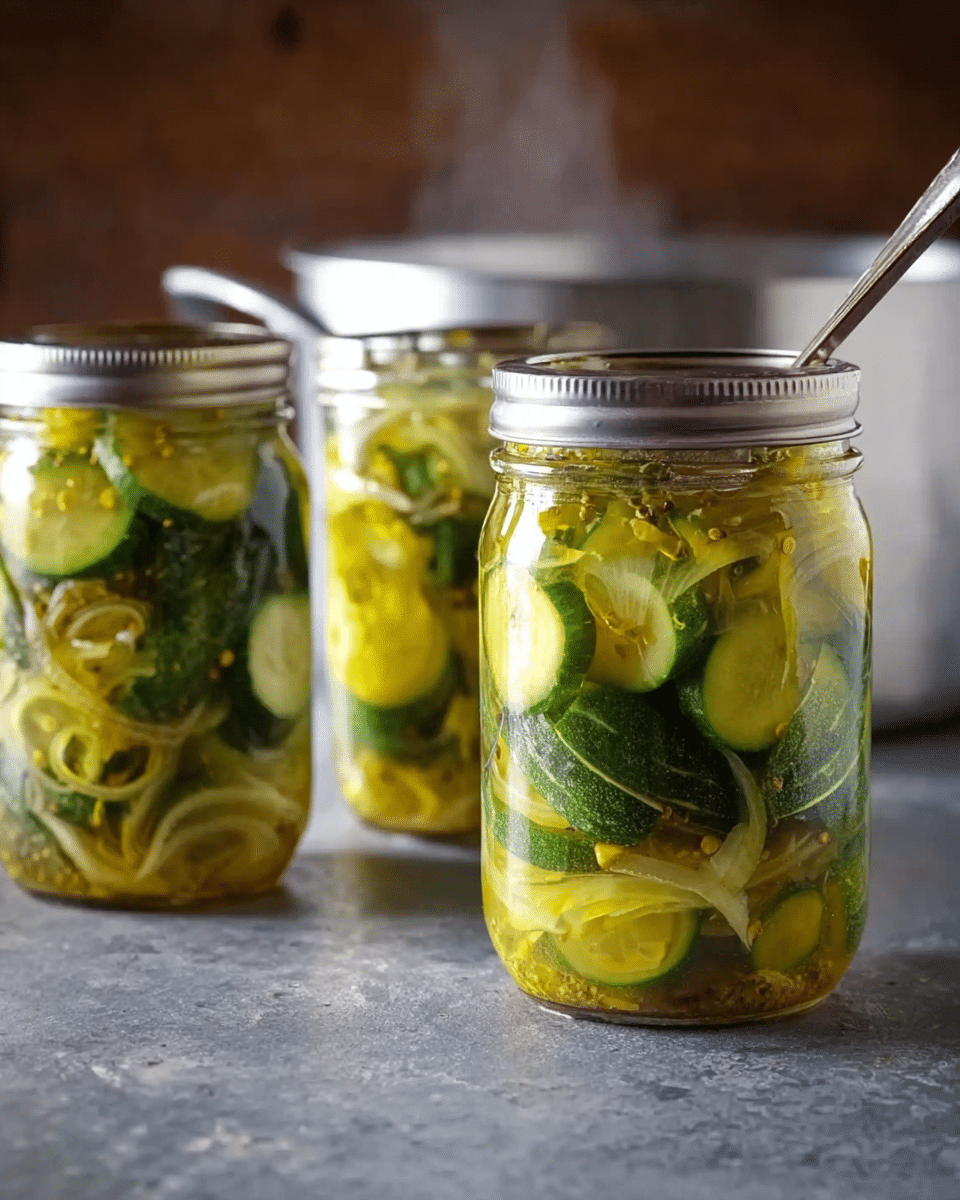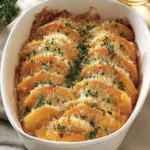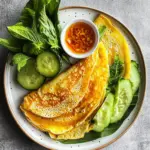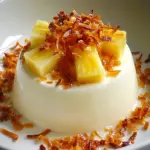These homemade bread and butter pickles are sweet, tangy, and incredibly crunchy—perfect for layering on burgers, tossing into tuna salad, or eating straight from the jar. Made with crisp Persian or Japanese cucumbers, thinly sliced onions, and a seasoned vinegar brine, this recipe uses an overnight drying step to ensure the coveted crunch. They store beautifully in the fridge for months and deliver a satisfying bite that rivals even the best store-bought brands.
Full Recipe:
Ingredients
-
3 lbs (1.36 kg) crisp cucumbers, sliced ¼-inch thick
-
½ medium onion, thinly sliced
-
¼ cup (75 g) kosher or sea salt
-
2 cups (480 ml) white vinegar
-
½ cup (120 ml) water
-
1 cup (200 g) sugar
-
2 tbsp (30 ml) mustard seeds
-
1 tsp (5 ml) celery seeds
-
1 tsp (5 ml) turmeric
Directions
-
Place cucumbers and onions in a colander over a bowl or sink. Toss with salt and let sit 1–2 hours to draw out water.
-
Rinse thoroughly, then spread in a single layer on paper towel–lined sheets. Cover with more paper towels and let dry overnight.
-
The next day, combine vinegar, water, sugar, mustard seeds, celery seeds, and turmeric in a saucepan. Bring to a boil, stir until sugar dissolves, and remove from heat.
-
Pack sterilized jars with cucumbers and onions, leaving ½-inch headspace.
-
Pour hot brine over vegetables, covering completely.
-
Seal jars following manufacturer’s instructions. For fridge storage, turn jars upside down for 15–20 minutes, then flip upright and cool. Store in fridge.
-
Let pickles sit several days before eating for best flavor. Serve chilled.
Nutrients (per serving, approx.)
-
Calories: 73 kcal
-
Carbohydrates: 15 g
-
Protein: 1 g
-
Fat: 1 g
-
Saturated Fat: 0.05 g
-
Polyunsaturated Fat: 0.1 g
-
Monounsaturated Fat: 0.3 g
-
Sodium: 439 mg
-
Potassium: 137 mg
-
Fiber: 1 g
-
Sugar: 14 g
-
Vitamin A: 62 IU
-
Vitamin C: 3 mg
-
Calcium: 21 mg
-
Iron: 0.4 mg
The Origin of Bread and Butter Pickles
Bread and butter pickles have roots in mid-20th-century American home kitchens, where they became a pantry staple due to their versatility and long shelf life. The name is thought to come from their pairing with bread and butter during the Great Depression, when the pickles added flavor to otherwise simple meals. Unlike dill pickles, which are sharper and more bracing, bread and butter pickles are known for their sweeter brine, subtle spice notes, and a tang that complements rather than overpowers. This balance makes them universally appealing, from those who love the bold flavors of pickles to those who prefer something milder.
Choosing the Right Cucumbers
The foundation of a great bread and butter pickle lies in the cucumber variety. Persian and Japanese cucumbers are ideal because they have thin skins, minimal seeds, and a naturally crisp texture. They absorb flavors well without becoming soft or mushy. Their smaller size also means that slices are uniform and fit nicely into jars. Freshness is essential—firm, unblemished cucumbers yield the best crunch and vibrant flavor. This choice of cucumber is one of the key differences between homemade pickles and many commercial varieties, where texture can sometimes be compromised during large-scale processing.
The Importance of the Overnight Drying Step
A defining feature of this recipe is the drying process. After salting to draw out excess moisture, the cucumber and onion slices are left to rest overnight between layers of paper towels. This step significantly improves texture, ensuring the final pickles are crisp rather than soft. It’s a technique borrowed from traditional pickling practices and makes all the difference in producing that satisfying snap when you bite into them. Skipping or rushing this stage can result in pickles that lose their crunch within days.
The Role of Onions
While cucumbers are the star, onions bring their own subtle magic. Thin slices of onion add a mild sweetness and aromatic complexity to the brine. They also absorb the tangy-sweet pickle liquid, becoming a flavorful garnish in their own right. These pickled onions can be used beyond the jar—tossed into salads, layered on sandwiches, or served alongside cheese and charcuterie boards. Their slightly softened texture contrasts beautifully with the firm cucumber slices.
The Flavor Profile of the Brine
The brine for bread and butter pickles is what sets them apart from other varieties. White vinegar forms the sharp base, balanced by water to soften the acidity. Sugar provides the signature sweetness, while mustard seeds, celery seeds, and turmeric contribute layers of spice and warmth. Mustard seeds add a subtle peppery heat and pleasant texture, celery seeds bring a mild earthiness, and turmeric imparts its signature golden hue, making the pickles as attractive as they are tasty. This brine is heated just enough to dissolve the sugar and release the aroma of the spices, ensuring the flavors are fully developed before being poured over the vegetables.
Packing and Storage
Proper packing ensures even flavor distribution and safe storage. Sterilized jars are filled with cucumber and onion slices, leaving space at the top to allow the brine to circulate and preserve texture. Pouring the hot brine directly over the vegetables allows for immediate infusion of flavor. While these pickles can be processed for long-term pantry storage, this recipe focuses on refrigerator pickles, which are simpler to prepare and maintain a fresher taste. Turning the jars upside down briefly before cooling helps to evenly coat the contents in brine during the initial setting period.
The Waiting Period for Peak Flavor
Although it can be tempting to dig in right away, bread and butter pickles reach their peak flavor after sitting for several days. This resting time allows the brine to fully penetrate the cucumbers and onions, melding the flavors together. The sweetness softens slightly, the tang becomes more integrated, and the spices have time to infuse fully. Patience is rewarded with a pickle that’s balanced, flavorful, and aromatic.
Serving Ideas and Versatility
The beauty of bread and butter pickles is in their versatility. Their sweet-tangy profile makes them an excellent counterpoint to rich or savory dishes. On a burger, they cut through the fat of the meat and cheese. In tuna or chicken salad, they add crunch and brightness. They work equally well alongside fried foods, where their acidity refreshes the palate. For entertaining, they can be served on appetizer boards with cheeses, cured meats, and crackers, or even chopped and folded into relishes and spreads. Their adaptability makes them a kitchen essential that can elevate both casual and more refined meals.
Why Homemade Beats Store-Bought
While quality store-bought bread and butter pickles are widely available, making them at home has distinct advantages. You control the ingredients, adjusting sweetness, tang, and spice to your preference. You can choose the freshest cucumbers, ensuring optimal texture, and avoid additives or preservatives that some commercial brands use. Homemade pickles also have a fresher, more vibrant flavor, and the satisfaction of crafting something from scratch adds a personal touch to your meals. Plus, they make thoughtful gifts—beautifully jarred pickles are a welcome treat for friends and family.
Nutritional Benefits
Though they’re not a health food in the traditional sense, bread and butter pickles do offer some nutritional value. Cucumbers are low in calories and provide small amounts of vitamins and minerals, including vitamin K and potassium. The onions contribute antioxidants, while the spices in the brine, like turmeric, are known for anti-inflammatory properties. However, because of the sugar and sodium in the brine, moderation is key. Enjoying them as a condiment or side rather than a main dish keeps their nutritional profile in balance.
Tips for Perfect Results
To achieve the best texture and flavor, start with the freshest cucumbers you can find. Maintain the drying step overnight to preserve crunch. Use a non-reactive pot for preparing the brine to avoid metallic flavors. Taste the brine before pouring—it should be sweet, tangy, and aromatic. If you prefer a more tart pickle, reduce the sugar slightly; for a sweeter version, increase it to taste. Finally, resist the urge to eat them too soon—letting them rest ensures a fully developed flavor.
Conclusion
Homemade bread and butter pickles are more than just a condiment—they’re a connection to tradition, a celebration of seasonal produce, and a simple pleasure that brightens countless dishes. Crisp cucumbers, tangy onions, and a delicately spiced brine come together to create a pickle that’s as satisfying to make as it is to eat. The overnight drying step ensures the ideal crunch, while the carefully balanced brine delivers the signature sweet-tangy flavor. Whether you enjoy them on a sandwich, beside a roast, or straight from the jar, these pickles offer a burst of flavor that can turn ordinary meals into something memorable. Making them at home gives you complete control over the taste, texture, and quality, resulting in a pickle that’s perfectly tailored to your palate and made to be shared with those you love.






